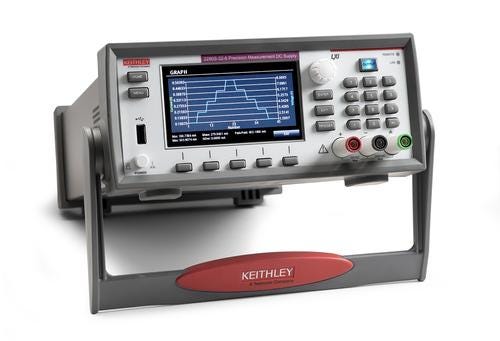Portable Wireless Device Characterization Requires Speed & Sensitivity
October 20, 2014

Portable wireless devices are seemingly everywhere today, from implantable medical devices to the RFID tags designed to deter shoplifting and thousands more. These devices must be compact, power efficient, and highly reliable. However, developers of these devices can find it challenging to determine accurately their power consumption at every operating stage, information that is critical to the power management strategy for the device. The instrumentation needed to monitor load currents must be capable of measuring very low-level currents when the device is in its sleep and standby modes. It must also be capable of making fast measurements during a device's active or transmit state. The challenge is that measuring low current has one set of requirements; making fast measurements has a completely different set.
Making good low current measurements requires instrumentation with micro-amp sensitivity or even better. To produce stable and accurate measurements, the test instrument needs high resolution, high accuracy measurement circuitry. It must also provide the flexibility to acquire low-level sleep mode or standby mode currents over a long measurement interval in order to average out electrical noise created in the device and noise from the external environment. Filtering can also be used to improve measurement accuracy. Therefore, to obtain a good low current sleep or standby measurement, it may be necessary to trade speed to get acceptable measurement accuracy. A measurement that extends over a number of AC power line cycles along with filtering can easily take more than two seconds to complete. The extended time, however, will help generate a high-confidence measurement.

In contrast, in order to measure, stimulate, or transmit load currents from medical devices or wireless industrial transmitters, the instrumentation must be capable of capturing a load current pulse that's present for only a few hundred microseconds and making the measurement after the pulse overshoot has settled. Current measurement circuitry must be optimized to respond quickly and make a measurement in a very short time interval. This situation requires trading off accuracy for speed. The measurement circuitry must have lower resolution and be capable of being optimized for speed. Figure 1 illustrates the requirements for instrumentation used to measure a pulse-like load current. The instrumentation must be able to respond to an external signal to know when the device is transitioning into an active state in which the load current pulse will be present. If the load current pulse overshoots before its peak stabilizes, the instrument should delay taking a measurement until the load current has reached a stable peak. The instrument should also allow flexibility in selecting a measurement time so that the best measurement can be acquired.
These opposing requirements for a slow, accurate measurement and a fast measurement might suggest that different instruments are needed to measure the low sleep mode and standby load currents and the short (but large) active mode currents. That is certainly one option. An engineer could place a sense resistor in series with the test lead that connects a power supply to the device-under-test and measure the voltage across the sense resistor with a digital multimeter (DMM). Installing the sense resistor in the test circuit adds an extra error term and increases measurement uncertainty. A smaller-value sense resistor could be used to reduce the additional error; however, if the sense resistor is too small, the DMM might not be sensitive enough to measure the low sleep mode current or even the standby mode current accurately. To capture the short stimulate or transmit pulses, the DMM would have to be able to make fast measurements and initiate them at a specific point in time, which would mean it would have to communicate with other instruments. The DMM would also need to delay the measurement start time to ensure the measurement was made during the appropriate portion of the load current pulse.

If the DMM cannot make fast measurements synchronized to an external trigger, then an oscilloscope would be required to capture the magnitude of the short load current stimulate or transmit pulses, which would also require adding a sense resistor in the circuit. Although this would solve the challenge of capturing the peak load pulse, oscilloscopes are not designed for sensitive DC measurements, so a DMM or other instrument would be needed for the low level measurements. To make all the necessary measurements, a power source, a DMM, and an oscilloscope might be required.
Although source measure unit (SMU) instruments might appear to be good solutions for this application because they can measure currents down to the picoamp level, most typically aren't designed to capture short pulses. However, they are generally low power instruments and so might lack sufficient total output power to deliver the peak current necessary to characterize a device like an implantable defibrillator. Also, because of their extraordinary sensitivity, SMU instruments can be relatively expensive.
Obviously, most device developers would prefer a solution that's easier to implement than some combination of a DC power supply to provide the source voltage, a sense resistor, a DMM, an oscilloscope, and an SMU instrument. Recently, instrument makers have begun to respond to the challenge of measuring both very low load currents and much higher active load currents of very short duration with power supplies that integrate fast, high sensitivity measurement capabilities (Figure 2).
To satisfy the market demand for low power wireless devices that combine extended operating life with a growing array of functions, device developers and production test engineers will require an extensive mix of test instrument capabilities. That means the next generation of power supplies must offer benchtop users the tools they need to monitor complex load currents accurately while providing the built-in communication interfaces essential for integrating them into high-speed automated test systems.
Robert Green is a senior market development manager at Keithley Instruments, Cleveland, Ohio, which is part of the Tektronix test and measurement portfolio.
Related posts:
About the Author(s)
You May Also Like





